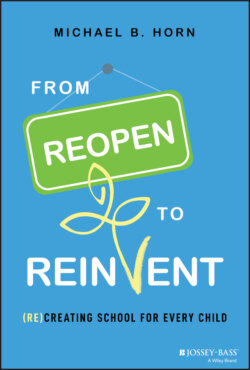Читать книгу From Reopen to Reinvent - Michael B. Horn - Страница 30
Microschool Movement
ОглавлениеMany school districts looked upon the rapid growth of microschools and learning pods during the pandemic as something akin to students signing up for the Russian School of Mathematics outside of school hours. They thought it was something certain families were doing to give their children a leg up on the other students around them. They wished these new schools would disappear.
But some districts took a different perspective.
As Eric Gordon, the CEO of the Cleveland Municipal School District, said, “Suburban communities were forming pods on their own. Why shouldn't my kids have those benefits?”19
The district leveraged new resources by working with a variety of community organizations—the Cleveland Foundation, MyCom, Say Yes Cleveland, and United Way of Cleveland—to open 24 pods during the pandemic and serve 808 of Cleveland's most vulnerable students.20
Cleveland was among the 11 percent of school districts, according to a national survey by the Clayton Christensen Institute, that operated “learning hubs” in the Spring of 2021. According to the survey, 5 percent of districts intend to continue operating pods postpandemic.21
The Center for Reinventing Public Education worked with TNTP, a nonprofit education consultancy, to create more in-depth partnerships with six school districts that would lead to something more lasting and transformational out of the pod movement.22
The DeKalb County School District in Georgia, for example, is using pods to reinvent alternative schools, which serve students who have dropped out or transferred from traditional schools. Given that many alternative schools have traditionally struggled, it's a place where the district thinks pods can help make a difference.
Edgecombe County Public Schools in North Carolina launched learning hubs during the pandemic to help students connect to online classes and receive in-person support. District leaders discovered that families valued increased flexibility around where and when learning happened, so they worked with students and teachers to design a “spoke-and-hub model.” Long-term, the district hopes this model will offer a new approach to school that builds stronger connections between school and community. In this more hybrid future of schooling, students would enroll in a brick-and-mortar or virtual school for the “hub” of their experience, and then elementary and middle school students would join “spokes”—or interest-based groups—for the other time. High school students would receive tutor-like support and work at paid positions or internships.
Guildford County Public Schools, which is also in North Carolina, is looking to craft school days in which high school students learn for three hours in person and then have more flexible time out of school to engage in a variety of activities, including completing assignments, working, or receiving tutoring or other enrichment opportunities. The district envisions this as part of a greater overhaul of their high schools that weren't serving many students effectively, even before COVID.23
Cleveland Learning Pods:
https://www.facebook.com/watch/?v=826632394829967
